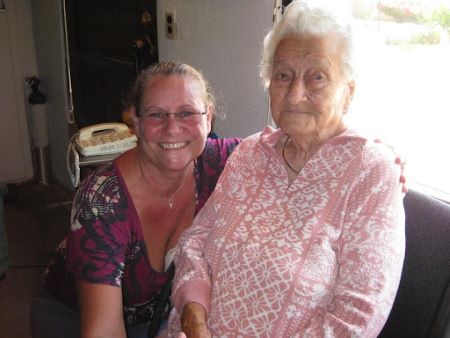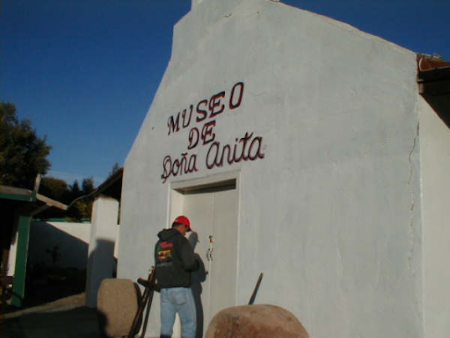 |  |
By David Kier

Anita Espinoza was born Anita Grosso and she would become the grand lady of El Rosario as well as one of the best-known Baja California personalities of the Twentieth and Twenty-first Centuries. Anyone traveling down the peninsula after World War II, knew about or would meet Señora Espinoza. Anita spoke perfect English and was the lady who helped visitors, often pumping gasoline, or cooking meals. Anita was known to travelers affectionately as ‘Mama’.
Thanks to Mama Espinoza’s 1994 autobiography, Reflections, we know the family history. Two other books also tell her life story: 1974’s Doña Anita of El Rosario (by Helen Ellsberg) and 2002’s Anita (by Martin Barron E.).
Anita was the daughter of an Italian father and a Pima Indian mother. Anita was also the youngest of ten children, all born between 1890 and 1908. Her father was Eugenio Eduardo Grosso Boutiare. He married 16-year-old Tecla Peña Duarte. They both worked in Santa Rosalía where the French Boleo Company was mining copper. After their marriage, the couple traveled around Baja California seeking new mine sites for the Boleo Company.
Eduardo and Tecla Grosso’s first child was named Arturo, born in San Ignacio in 1890. Arturo would grow up and become the owner of Rancho Laguna Chapala. In the mid-1950s, Arturo built the first road connecting his ranch with Gonzaga Bay and San Felipe. Like his father, Arturo Grosso was also into mining and would have many prospects in the region around Laguna Chapala.

In 1892, Angelo was born while the Grosso’s were living in Las Flores (just south of Bahía de los Angeles); Juan was born in 1894; Eduardo in 1896; Emilio in 1898; Teresa was their first daughter, in 1903; Eugenio arrived in 1905; Adelaida in 1906; and Amalia in 1907. Anita writes that she was born on October 16, 1908, in El Rosario. Anita says that these dates were what they were told. There was no public registry book in El Rosario until 1910, the year other books cite for her birth. The 1930 El Rosario Census states Anita Grosso was 22-years-old, giving some credence to her stated birth year.
The Mexican Revolution came to Baja California in 1911. Mexico didn’t seem safe for the many Europeans of Baja California. Grosso, being Italian, moved his family across the border to Calexico. Anita was just three-years-old, and the wagon trip took weeks as they followed the mission trail north to San Vicente and on through the Guadalupe Valley to Jacumba, then down to Coyote Wells and finally, Calexico.
In Calexico, the Grosso children went to school and learned English. During the years of the Spanish Flu, Anita remembers many neighbors who died and how black bows were put on doors of their homes. Around 1922, with money from mining all gone, Eduardo Grosso sold the house in Calexico and moved the family to Encanto, near San Diego. The family began raising rabbits for food and income. Eduardo returned to Mexico to seek new mining fortunes. Tecla and her daughter Amalia knitted sweaters. Anita, already a good salesperson, went with brother Emilio door to door selling sweaters and rabbits to help the family. Teresa married a Mexican army colonel and the newlyweds moved to Mexicali. They took Anita and Amalia with them. Anita lived in Mexicali for three years. For three months of 1926, Anita tells us she was briefly married, but that it was a sad memory.
Early in 1927, the Grosso family returned to El Rosario. Anita became a first-grade-class teacher. Eventually, Anita met Heraclio Espinoza. He was the eldest son of Santiago and Josefa Espinoza Peralta. Heraclio managed the family cattle ranch. Anita saw Heraclio as a handsome and dashing cowboy. Her mother did not, and never did approve of Heraclio!

On August 28, 1932, Anita and Heraclio Espinoza were married. They first lived in El Rosario’s river valley where Heraclio tended to the cattle and Anita worked in the gardens. In a few months, Anita began making baby clothes! Socorro arrived in 1933; Mario in 1934; Lucio in 1935; María or ‘Chichi’ in 1937; Eugenio in 1939; Elva or ‘Rolli’ in 1942; Heraclio or ‘Pingo’ in 1944; Santiago or ‘Jimy’ in 1945; Sergio or ‘Sony’ in 1947; and Antonio or ‘Tony’ in 1949. Like her mother, Anita also had ten children!
In 1937, the Espinoza’s moved to the family ranch of El Metate, near San Juan de Dios (today called Rancho Las Palmas). Later that same year, Anita’s father returned to El Rosario. He is buried in the mission cemetery. Heraclio received a government permit to serve as a hunting guide. He was guiding some American military colonels and majors, out on a bighorn hunt. One evening, when the Americans turned on their radio to hear the news, they learned Peral Harbor was attacked. They immediately packed up and left for the border, giving all their surplus gear to the Espinoza’s. This was in December of 1941.
Ten days later, a messenger riding on a mule arrived at El Metate, with a mandate. The Japanese were expected to use Baja California to attack the United States. All civilians were ordered to concentrate in towns. The Espinoza family moved back to El Rosario where they had remained ever since. A Mexican Army battalion was established in El Rosario. Americans also began arriving in Jeeps and Power Wagons. They came to build the airstrip up on the mesa for use by coastal patrol planes. They built other airstrips, roads, and radar stations in Baja California, all to prevent a Japanese invasion.
After the war, more Americans began to appear driving Jeeps and Power Wagons. Anita and her family moved into the room that had been used for an army radio-telegraph. This would become ‘Espinoza’s Place’ that we know today. English-speaking Anita sold gasoline and cooked meals. Many travelers came to know her from doing those things.
The Flying Samaritans (doctors in planes) really appreciated Mama’s assistance. That group was actually created following an emergency landing up on the mesa in 1961. After Mama helped the shaken passengers, they learned of the lack of medical services in El Rosario. These flying doctors would establish a clinic at Espinoza’s Place. They came to El Rosario regularly, offering medical services to the area residents.
Off-Road Racing and dinosaur bone searching also arrived in the 1960s. That really put El Rosario and Mama Espinoza’s on the map. Mama Espinoza’s cooking attracted visits from Parnelli Jones and Mickey Thompson, for a time. During pre-running, Mickey would stop and eat five or six lobster tacos. The demand for lobster tacos, burritos, and omelets has soared ever since.

In early 1973, pavement arrived in El Rosario and the slow-paced life came to an end. Mama Espinoza is well-known for saying, “Bad roads, good people; Good roads, all kinds of people!”
In 2006, the museum of Doña Anita Espinoza’s life and collections was opened by request.
My wife and I had the good fortune to visit with Mama (Doña Anita) Espinoza, in 2009. This was just before her 101st birthday. She was very gracious, and she signed one of her books for us. Mama passed away on March 12, 2016, at 5:30 in the morning.
About David
David Kier is a veteran Baja traveler, author of 'Baja California - Land Of Missions' and co-author of 'Old Missions of the Californias'. Visit the Old Missions website.